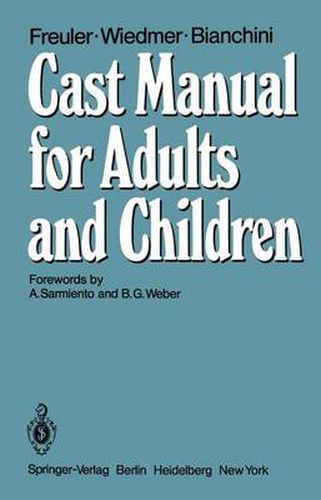Readings Newsletter
Become a Readings Member to make your shopping experience even easier.
Sign in or sign up for free!
You’re not far away from qualifying for FREE standard shipping within Australia
You’ve qualified for FREE standard shipping within Australia
The cart is loading…






This title is printed to order. This book may have been self-published. If so, we cannot guarantee the quality of the content. In the main most books will have gone through the editing process however some may not. We therefore suggest that you be aware of this before ordering this book. If in doubt check either the author or publisher’s details as we are unable to accept any returns unless they are faulty. Please contact us if you have any questions.
The publication of this Cast Manual is very timely. Technological advances made in the past two decades have resulted in increased popularization of open reduction and internal fixation in the treat ment of long bone fractures. Due primarily to incorrect application of those techniques, it has become increasingly apparent that its routine and casual use can result in complications - oftentimes of catastrophic nature. Students and practitioners of orthopedics must keep uppermost in their minds that osteogenesis takes place spontaneously through an orderly and physiological process. Surgical intervention and the intro duction of a foreign body at the fracture site alters that process. Though the fracture heals, it does so not because of the mechanical device but in spite of it. Therefore, internal fixation must be reserved only for those instances when its practical advantages heavily out weigh its biological disadvantages. The success of nonsurgical treatment of fractures is also predicated on the clear understanding of fracture healing and the proper application of stabilizing techniques. This cast manual emphasizes the importance of proper application of various casts and discusses very well those details which are important for the success of nonsurgical treatment of fractures. Dr. F. FREULER, Dr. U. WIEDMER, and D. BIANCHINI’S Cast Manual must be read carefully by students of orthopedics and used as a reference book for those who should keep abreast of new concepts and techniques of closed management of fractures. Summer 1979 AUGUSTO SARMIENTO, M. D.
$9.00 standard shipping within Australia
FREE standard shipping within Australia for orders over $100.00
Express & International shipping calculated at checkout
This title is printed to order. This book may have been self-published. If so, we cannot guarantee the quality of the content. In the main most books will have gone through the editing process however some may not. We therefore suggest that you be aware of this before ordering this book. If in doubt check either the author or publisher’s details as we are unable to accept any returns unless they are faulty. Please contact us if you have any questions.
The publication of this Cast Manual is very timely. Technological advances made in the past two decades have resulted in increased popularization of open reduction and internal fixation in the treat ment of long bone fractures. Due primarily to incorrect application of those techniques, it has become increasingly apparent that its routine and casual use can result in complications - oftentimes of catastrophic nature. Students and practitioners of orthopedics must keep uppermost in their minds that osteogenesis takes place spontaneously through an orderly and physiological process. Surgical intervention and the intro duction of a foreign body at the fracture site alters that process. Though the fracture heals, it does so not because of the mechanical device but in spite of it. Therefore, internal fixation must be reserved only for those instances when its practical advantages heavily out weigh its biological disadvantages. The success of nonsurgical treatment of fractures is also predicated on the clear understanding of fracture healing and the proper application of stabilizing techniques. This cast manual emphasizes the importance of proper application of various casts and discusses very well those details which are important for the success of nonsurgical treatment of fractures. Dr. F. FREULER, Dr. U. WIEDMER, and D. BIANCHINI’S Cast Manual must be read carefully by students of orthopedics and used as a reference book for those who should keep abreast of new concepts and techniques of closed management of fractures. Summer 1979 AUGUSTO SARMIENTO, M. D.